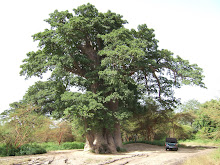If you want a better picture of what the community is like that we live in, or if you are holding onto the fading hope that my writing might one day be more interesting or at least grammatically correct and today might be the day for that long awaited metamorphosis, then read on.
The area of Dakar that we live in is called “Ouakam”. Tamara teases me that I spell it differently every time, but the altered spellings seem to fit the theme of this trip; random wanderings in a continent where nothing is as formalized, as set in stone or as transparent as home… at least from our point of view. Who knows, probably for the folks here everything does have a rhythm and a sense, it’s just harder for us Canadians to see. Of course when it gets down to it, I don’t really know how Oukam (or Ouakham) is supposed to be spelled. In any case, that is where we live.
Ouakam is north of downtown, not too far from the airport, tucked in between the Senegalese and French army bases and the Atlantic Ocean. The closest beach is about a fifteen minute walk away, lined with colourfully painted pirogue fishing boats and home to a very cool mosque that has rounded turrets on top akin to the Cloud City-esque architecture of Bespin. Five times a day we hear the call to prayer that is amplified from the topmost tower of the mosque across the whole neighbourhood. The highway Cheikh Anta Diop runs through Ouakam right to the N’Gor, which is the westernmost point in all of Africa. The few blocks of red dirt and black tarmac that we would consider our hood is full of the goings on of city life. For one, there is constant traffic. There are the flowery-painted Car Rapides and white Ndiage Ndiayes, which are basically big vans that can carry up to 30 people. They go downtown for 150F CFA (about $.40) There are also the big blue Dakar Dem Dikk (‘Dakar return trip’ in Wolof) buses that have routes all over the city at the rate of 200F CFA per ride. More than half the cars on the road are taxis in various states of disrepair and they constantly pass by honking at anyone who doesn’t even look half interested in a ride. Taxi fares are negotiable, which can be a lot of fun once you know what the prices should be and you develop a knack for tough negotiations. The toubab (white folk) price for a taxi to downtown from Ouakam is 2000F CFA (about $5), while the price for Senegalese people is about 1500F CFA ($3.75). However, the taxi drivers usually have the audacity to ask for 4000F right off the bat and are always a little put out when you explain that you live here and thus know that ‘deux mille c’est bon!’
Our house is in a walled courtyard about 25 m from the main road. Walking onto Cheik Anta Diop, right across the street, is the first fruit vendor that we meet in Dakar. For the first month or so we bought oranges, mangos and grape fruit off of him. Usually 2 kg of the latter was 1400 CFA ($3.50), which usually resulted in 5 plump little pamplemousse in our bag. But then we tried out the competition up the road and found that we could get six for 1200 CFA, so we’ve switched suppliers. A little further north you would come across the Total gas station. It is a very modern looking station, with all the European amenities you would expect from such an establishment (overpriced gas ($2/litre), chocolate bars ($1.50), pop, juice and wine. Across the street form the Total is our favorite street vendor of all, the “Legume Lady”, or the vegetable lady. We’ve been going to her for our greens since we arrived and although the prices fluctuate wildly (from $3.75-$6.25 for the same produce), the service is always with a smile. In any case, if we pretend not to have more than $5 she will still sell us a good bag full. The Legume Lady is Peoul, which is an ethnicity in West Africa that can be found all over the region. I first heard about the Peoul when I was watching the five-part National Geographic series Africa. It showed the young men herding their cattle over thousands of kilometers of Sahel and the Peoul girls with their elaborate and beautiful dresses and jewelry. The average girl wore enough amber in her hair and gold around her neck to stock a full Spence Diamonds. The girls also henna around their mouths, making a large black outline of their lips reaching down to just above their chins. I noticed that the Legume Lady had the faint tracings of henna in the same place. When we got to know her and her family better they told us that they were Peoul and that they had originally moved from the countryside to Dakar.
Anyways… that was a bit of a diversion. The following entry will go into our deepening relationship with the Legume Lady and her family.
Friday, 19 December 2008
Subscribe to:
Post Comments (Atom)

No comments:
Post a Comment